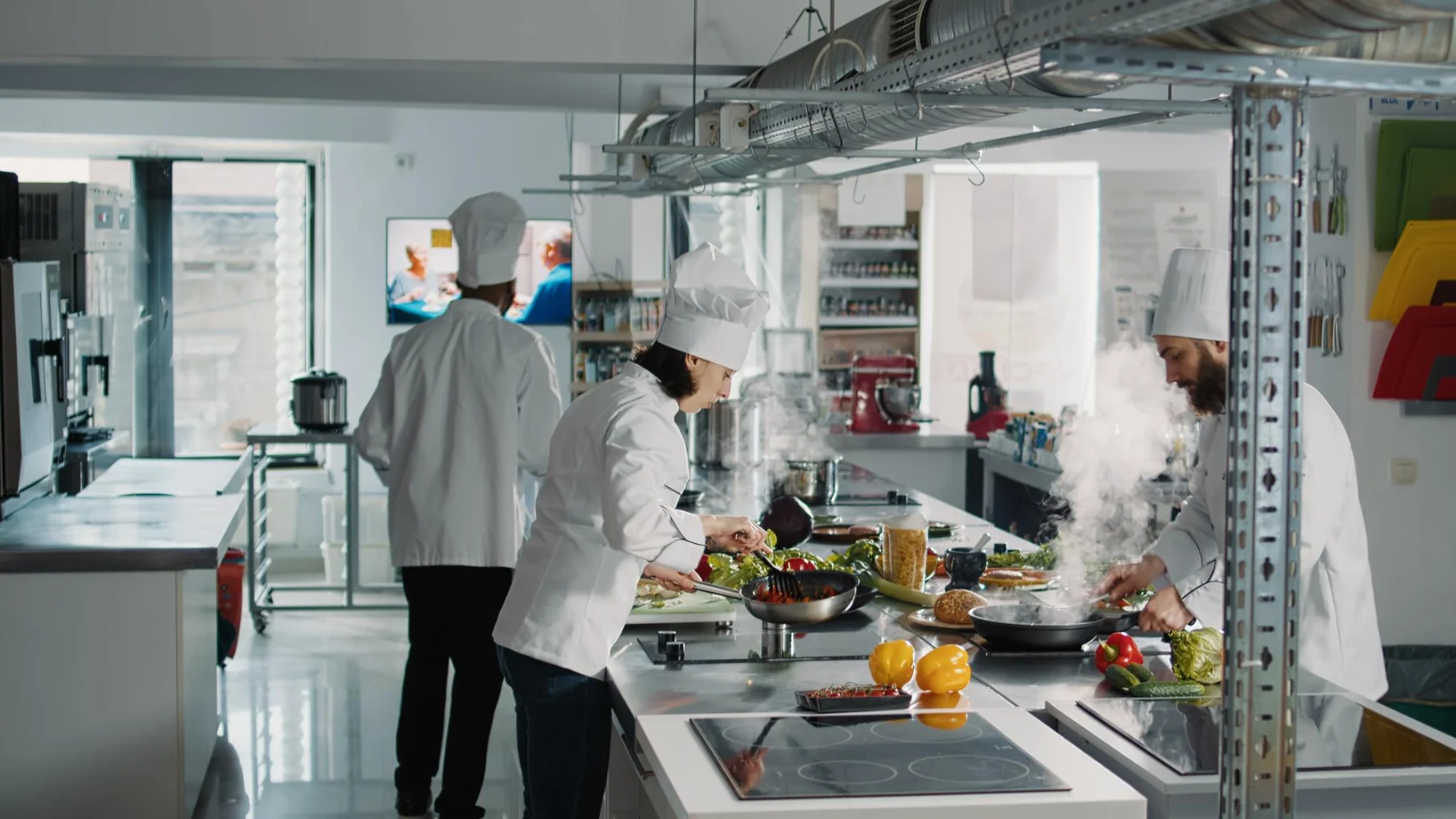Quick Links
ToggleWhile some people keep wondering what a cloud kitchen is and whether it’s the right move, others take the leap and end up building successful food businesses without ever setting up a traditional restaurant. The concept of cloud kitchen has rapidly gained popularity in India, driven by the booming demand for online food delivery services—especially after the COVID-19 pandemic. With the number of online food delivery users expected to reach 2.9 million by 2026, the opportunity has never been more promising. In fact, the Indian cloud kitchen market was valued at USD 1.3 billion in FY2024 and is projected to grow to USD 4.4 billion by FY2032, expanding at a CAGR of 16.63%.
If you’re ready to get started but unsure how, you’re in the right place. In this guide, we’ll walk you through how to start a cloud kitchen from scratch, covering everything from choosing your space to getting listed on delivery platforms. Let’s get into it.
Explained: How to Start Your Cloud Kitchen
Here’s how you can get started with a cloud kitchen:
-
Step 1: Define Your Niche and Food Concept
Start by narrowing down who you want to serve. Are you planning meals for busy working professionals, college students, or families? Once you know your audience, pick a cuisine and food concept that meets their needs.
Focus on dishes that are easy to prepare, offer good margins, and stay fresh during delivery. For example, biryanis, rolls, pastas, and rice bowls are great cloud kitchen choices because they travel well and don’t lose quality on the way.
Pro tip: Find a USP (unique selling point). It could be value meals, healthy bowls, regional food, or quirky branding. -
Step 2: Create a Lean Business Plan
You don’t need a 100-page document, just a simple plan that covers the basics:
- How much money do you need to get started?
- What kind of order volume are you expecting each day?
- How will you price your items and stay profitable after aggregator commissions?
- Do you want to start with one brand or run multiple cuisines from the same kitchen?
Getting clarity here will help you make smarter choices when it comes to setup, menu design, and marketing.
-
Step 3: Choose the Right Location
Unlike regular restaurants, cloud kitchens don’t need a prime retail spot. Look for a place that’s affordable but still close enough to a large delivery radius.
Search for areas that have good order demand on apps like Zomato or Swiggy but not too many competing outlets. Lower rental costs and high delivery traffic can help your business stay sustainable from the start.
-
Step 4: Get Legal and Set Up Your Kitchen
No matter where you operate from, registration and hygiene are non-negotiable. Make sure you get the following in place:
- FSSAI License (mandatory for food businesses)
- GST Registration
- Fire Safety NOC
- Shops and Establishment License from your local municipality
Once the legal part is done, set up your kitchen with the basics:
- Cooking equipment (stove, fridge, prep tables)
- Food-grade storage containers
- Quality packaging material
- Hygiene tools like gloves, hairnets, and sanitizers
Even if you’re starting from home, food safety and cleanliness should be your top priority.
-
Step 5: Build a Strong Tech Setup
Running a cloud kitchen efficiently requires good backend support. Use restaurant tech tools like Zopping for Restaurants to manage:
- Orders from multiple platforms (Swiggy, Zomato, etc.)
- Kitchen Display Systems (KDS)
- Billing and inventory tracking
- Delivery tracking and performance reports
A solid tech system saves time, reduces errors, and helps you scale faster without losing control.
-
Step 6: Register on Food Aggregator Platforms
Your cloud kitchen won’t go far if people can’t find it online. So, sign up with food delivery platforms like Swiggy and Zomato.
Make sure your menu is easy to read, has appealing dish names, and includes clear photos of the food. You can also use search-friendly keywords in your dish names to appear in more customer searches.
To get early traction, try running discounts and promotions through these platforms.
-
Step 7: Focus on Packaging and Delivery Experience
How your food arrives at the customer’s door matters just as much as how it tastes. Invest in packaging that is sturdy, spill-proof, and keeps the food warm. If possible, go for eco-friendly options.
Add small touches like branded tissue paper, QR codes for reviews, or stickers with your logo. These little things help you build a brand and create a lasting impression.
Also, make sure your delivery team is reliable and punctual. You can either partner with the aggregator’s delivery network or hire your own riders if you’re doing direct deliveries.
-
Step 8: Market Your Cloud Kitchen
Don’t just rely on food delivery apps to bring in orders. Run your own promotions on Instagram, connect with local influencers, and get your name out there.
You can also offer:
- Discounts for first-time orders
- Referral bonuses for customers who bring in friends
- Loyalty offers for repeat customers
Encourage customers to leave reviews and share pictures. This builds trust and gives you free word-of-mouth publicity.
-
Step 9: Monitor, Improve, and Scale
Once your kitchen is up and running, it’s important to keep an eye on your numbers. Look at things like:
- Daily sales
- Order preparation time
- Delivery ratings
- Customer feedback
Use these insights to improve your menu, cut down delays, and test out new items. If things are going well, you can expand by launching more brands under your kitchen or open another cloud kitchen in a different area.
Can You Start a Cloud Kitchen from Home?
Yes, you can absolutely start a cloud kitchen from home, and many people are already doing it successfully. It’s one of the easiest ways to get into the food business without needing to rent a full-scale restaurant space.
To get started, you’ll need a clean, functional kitchen space where you can prepare food safely. It could be your home kitchen, but you might need to make a few upgrades depending on your state’s food safety rules. You’ll also have to register your business, get an FSSAI license, and follow any local health regulations. It’s a good idea to contact your local municipal office to understand the requirements clearly.
Once your setup is ready, you can list your kitchen on delivery platforms like Zomato, Swiggy, or even take orders directly through WhatsApp or Instagram. Your focus should be on building a solid menu, keeping your food quality consistent, and making sure your packaging keeps the food fresh until it reaches the customer.
A home-based cloud kitchen keeps your costs low because you don’t have to pay rent for a separate commercial space. It’s a great option if you want to test your recipes, build a loyal customer base, or even grow into something bigger later on.
Budget Breakdown & Cost Estimation for starting a cloud kitchen
Here’s a closer look at what you might need to spend while starting a cloud kitchen:
One-Time Setup Costs
- Basic kitchen setup: ₹10,000 to ₹30,000 (if upgrades are needed for commercial use)
- FSSAI license: ₹1,000 to ₹5,000 (depends on the scale and duration)
- Business registration: ₹2,000 to ₹10,000
- Packaging materials: ₹5,000 to ₹10,000 (initial stock of boxes, containers, labels)
- Cooking equipment (if not already owned): ₹10,000 to ₹90,000 (gas stove, mixer, fridge, etc.)
- Digital setup: ₹2,000 to ₹5,000 (for a basic menu design, WhatsApp Business setup, or Instagram promotion)
Monthly Recurring Costs
- Raw materials/ingredients: ₹15,000 to ₹40,000 (varies by menu size and volume)
- Utility bills (gas, electricity, water): ₹2,000 to ₹5,000
- Food delivery platforms commission: 15% to 30% per order (Zomato/Swiggy charges)
- Marketing & promotions: ₹2,000 to ₹8,000 (optional but helpful for growth)
- Packaging restock: ₹3,000 to ₹7,000
- Manpower (if hired): ₹8,000 to ₹15,000 per person
Optional Costs
- Small website or ordering system: ₹5,000 to ₹15,000
- Photography & branding: ₹2,000 to ₹10,000 (for menus and social media)
- Advanced kitchen tools or appliances: ₹5,000 and above (for scaling up)
Common Mistakes to Avoid While Starting a Cloud Kitchen
Here are a few common mistakes you should avoid while starting a cloud kitchen:
-
Jumping in Without Market Research
Before you even think about setting up your kitchen, take time to understand your target market. What kind of food are people in your area actually ordering? Are there already 10 biryani kitchens within 3 km? If you skip this step, you might end up offering something no one wants or competing in an overcrowded space. Always research food trends, customer preferences, and local competition before finalising your menu.
-
Poor Branding and Online Presence
Just because you don’t have a dine-in space doesn’t mean branding isn’t important. Your packaging, menu design, food photos, and even how you respond to reviews can make or break your brand. Many first-time cloud kitchen owners skip proper branding, which hurts their ability to stand out on food delivery platforms. Remember, online is your only storefront, so make it count.
-
Not Focusing on Packaging
Your food might taste amazing, but if it arrives cold, spilled, or soggy, your customer experience is ruined. A lot of beginners cut corners on packaging to save costs, but this only leads to refunds and bad reviews. Always invest in packaging that keeps your food fresh, safe, and presentable when it reaches the customer.
-
Overcomplicating the Menu
It’s tempting to serve everything you’re good at, but a long and complicated menu slows down the kitchen, leads to inventory issues, and confuses customers. Start small. Focus on a few items you can consistently deliver well. This helps with quality control, easier inventory management, and a clearer brand identity.
-
No Inventory or Cost Control
Running out of ingredients or not knowing your food cost margins can hurt your business faster than you think. Many first-time owners don’t track how much they’re spending versus earning. Use tools or simple spreadsheets to manage inventory and calculate food costs. This helps you price your menu right and avoid wastage or losses.
-
Ignoring Customer Feedback
Your first few weeks will be filled with valuable customer feedback. Some will praise, some will complain, and both are useful. Don’t ignore it. Keep an eye on reviews, ratings, and messages. Reply politely, make improvements, and use feedback to shape your menu, portion size, and service. It’s one of the easiest ways to grow.
-
Not Building Repeat Customers
If your only strategy is to show up on delivery apps and hope for orders, you’ll struggle to grow. Cloud kitchens need to build loyal customers who keep coming back. Offer small discounts to returning customers, focus on delivering consistently good food, and slowly build a following on Instagram or WhatsApp for direct communication.
-
Relying Only on Third-Party Apps
Delivery apps are great for visibility, but they also take a big chunk of your earnings. Don’t rely only on them. Start building your own direct ordering channel through a website, Instagram DMs, or WhatsApp. You’ll earn more from each order and build better customer relationships without platform fees eating into your profits.
-
Trying to Do Everything Alone
A lot of cloud kitchen owners try to handle cooking, marketing, packaging, and customer service all by themselves. This only leads to burnout and errors. Delegate where possible. Hire kitchen staff, get help with social media, or use platforms that automate ordering and feedback. You don’t need a big team, just a smart system that helps you focus on the food.
Closing Thoughts
Starting a cloud kitchen is not just about cooking and delivering food, it is about building a business that people trust and enjoy coming back to. When you focus on the basics like good food, clean packaging, reliable delivery, and smart marketing, you set yourself up for steady growth. Take things step by step, avoid common mistakes, and keep improving as you go. With the right approach, a cloud kitchen can grow from a small idea into a strong and lasting food brand.
Ready to take the next step?
Let Zopping simplify your cloud kitchen journey from day one. From managing orders across platforms to tracking inventory and improving delivery performance, Zopping gives you the tools to run your kitchen smartly and scale with ease.
Try Zopping today and see how much smoother your kitchen can run.Key Takeaways
- A cloud kitchen allows you to run a food business without the cost of a traditional restaurant, making it a smart entry point for new entrepreneurs.
- Success depends on choosing the right niche, keeping the menu simple, and focusing on food quality, packaging, and delivery.
- Legal licenses, hygiene standards, and a reliable tech setup are essential to run operations smoothly and build trust.
- Marketing on social media and food delivery apps helps attract new customers, but building repeat orders and direct channels ensures long-term growth.
- Avoid common mistakes like poor branding, ignoring customer feedback, or relying only on aggregator platforms.



